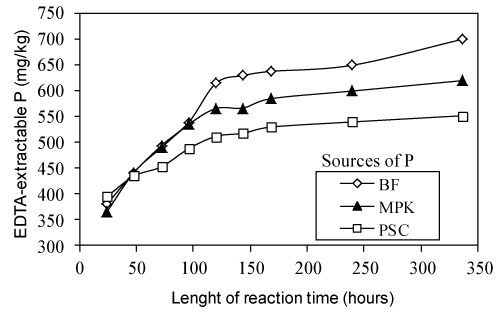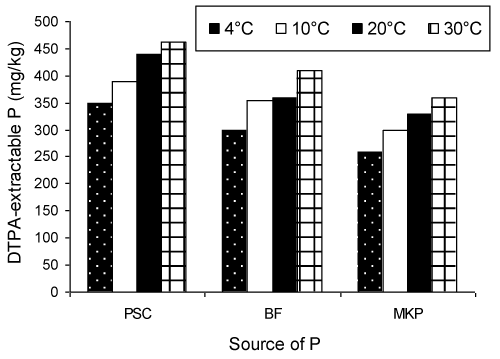Research Article Open Access
Availability of Three Phosphorus Fertilizers to Corn Grown in Limed Acid-Producing Mine Tailings
| Aajjane A1*, Karam A2 and Parent LE2 | |
| 1 Université Chouaïb Doukkali, Faculté des Sciences, Equipe des Sciences du Sol, El Jadida, Morocco | |
| 2 E.R.S.A.M., Département des Sols et du Génie agroalimentaire, FSAA, Université Laval, (QC) G1K 7P4, Canada | |
| Corresponding Author : | Aajjane A Université Chouaïb Doukkali Faculté des Sciences, Equipe des Sciences du Sol El Jadida, Morocco Tel: 212-664164940 Email: aajjane.a@ucd.ac.ma |
| Received September 21, 2013; Accepted May 23, 2014; Published May 28, 2014 | |
| Citation: Aajjane A, Karam A, Parent LE (2014) Availability of Three Phosphorus Fertilizers to Corn Grown in Limed Acid-Producing Mine Tailings. J Bioremed Biodeg 5:229. doi:10.4172/2155-6199.1000229 | |
| Copyright: © 2014 Aajjane A, et al. This is an open-access article distributed under the terms of the Creative Commons Attribution License, which permits unrestricted use, distribution, and reproduction in any medium, provided the original author and source are credited. | |
Related article at Pubmed Pubmed  Scholar Google Scholar Google |
|
Visit for more related articles at Journal of Bioremediation & Biodegradation
Abstract
Liming can modulate phosphorus (P) availability to plants growing in acid-forming media. The objectives of this study were to determine the effects of lime and phosphorus rates on corn (Zea mays L.) grown under greenhouse conditions on an acid-producing mine tailing, and to evaluate P desorption from the mine tailing after harvest. The acid-sulfide tailing (pH 2.65) collected from the Solbec-Cupra mine in Quebec was limed using CaCO3 to theoretical pH values of 5 (11 g/kg), 6 (17 g/kg) and 7 (30 g/kg) prior to corn production. Phosphorus was thoroughly mixed with the tailing at rates of 0, 22.4, 44.8 and 89.6 mg P/kg. Commercial peat-shrimp waste compost; a commercial bone flour fertilizer and reagent-grade KH2PO4 were used as P sources. Corn (Zea Mays L. cv. 'Pride 1122') was grown for 50 days after emergence. After harvest, the mean tailing pH values varied from 4.20 to 7.20. Dry matter yield of plant tops was significantly affected by lime and phosphorus treatments. Corn yields were significantly correlated with pH, salinity index (electrical conductivity of aqueous extracts) and ammonium acetate-extractable Ca and Mg. In all P treatments, the highest yield was obtained with plot receiving 44.8 mg P/kg and lime rate to achieve pH 6 (17 g of CaCO3/kg). In general, mineral composition of the tops did not show toxic accumulation of trace metals. The P extracted by Na2EDTA from some tailing samples was a time-dependent process. Results from another P desorption study indicated that the amounts of DTPA-TEA-CaCl2 (pH 7.3) extractable substrate P increased with temperature. The DTPA-extracted P data from the 30 tailing samples over a period of 1 to 48 hours were best described by an empirical first-order-rate equation using t0.5 instead of t as the time variable. Liming and P fertilization were determinant factors for the growth of corn in acid sulfide tailings.
It is known that P availability in limed acid soils depends on pH and P fixing capacity [5]. It has been reported that pH is an important factor in P release from rock phosphate-pyrite mixtures. Although P fertilization has been found essential for good revegetation of coal mine spoils, the fertilizer requirement should be enhanced in limed acid tailing.
The objectives of this study were to determine the effects of lime and phosphorus on corn grown on a highly acid-producing mine tailing, and to examine the P desorption characteristics of the tailing after harvest.
After harvest, mine tailing samples were air-dried and crushed to the original size prior to analysis. The chemical properties of tailing samples and P desorption in relation to temperature and extration time was determined following standard methods as described by Carter [6]. The dissolution of tailing P in EDTA solution over a period of 1 to 14 days was also investigated for some tailing samples. EDTA-extractable P could be considered a source of labile P related to crop response [7]. In another P desorption study, reaction rate of P desorption was evaluated for each cultivated tailing sample using DTPA-TEA-CaCl2 (pH 7.3) as extracting solution and 1, 12, 24 and 48 hours as extraction time. The DTPA method was used to minimize the dissolution of CaCO3 [8] during the extraction in all limed tailing samples. Tailing pH was determined in distilled water using a tailing to solution ratio of 1:1. Electrical conductivity was measured after mixing 30 g of tailing with 30 mL of distilled water. Other analysis included the followings: Mehlich 3-extractable nutrients (P, Ca, Mg, K), ammonium acetate-extractable Ca, Mg and K, acid ammonium oxalate-extractable Fe and P, Na2EDTA-extractable and DTPA-extractable Fe and P. Phosphorus was determined calorimetrically and metal cations were determined by atomic absorption spectrophotometry. Analysis of variance was conducted using the General Linear Model (GLM) statistical programme of the SAS package [9]. Linear correlation and regression analyses were used to determine the effect of chemical properties of the growing media on corn growth.
The maximum yield is obtained at intermediate liming (Table 1). There was a highly significant correlation (P<0.001) between P uptake by corn and both tailing pH (r=-0.786) and oxalate-extractable Fe (r=0.762). In general, heavy metal cations (Zn, Cu, Fe and Mn) in corn tissues decreased with lime rate (data not shown).
The Mehlich 3 solution used as a soil test for available-plant P level in Quebec extracted higher amounts of tailing P (PM3) than the acid ammonium oxalate method (Pox) (Table 1). The amount of PM3 varied from 32.7 to 49.5% of total P with an average of 42%. Inclusion of independent variables that met the 0.500 significance level for entry into multiple linear regression, e.g. PM3, PM3/total P ratio, and Mehlich-3 extractable Ca and Mg increased the R2 value to 63.9%.
In another series of experiments, the amounts of P extracted by DTPA-TEA-CaCl2 (DTPA) increased nonlinearly with extraction temperature (Figure 2), indicating that P desorption by DTPA was an endothermic reaction.
PSC: commercial peat-shrimp wastes compost; BF: commercial bone flour; MKP: reagent-grade KH2PO4
For mineral soils, Beaton et al. [14] found that the rate of dissolution of pellets containing 15 mg of P prepared from water-soluble P fertilizers increased markedly as extraction temperature was increased from 5° to 35° C. Numerous reports indicated that the optimum growth conditions for common microorganism species in the sulfide tailings such as Thiobacillus ferrooxidans is 30° C [15]. In general, the release of DTPA-extractable P in relation to temperature from tailing samples increased in the following order: MKP<BF<PSC (Figure 2). The activity of microorganisms involved in the decomposition of organic P into inorganic P or in the oxidation of iron sulfide into P-fixing iron hydroxide could be stimulated as temperature rose from 4° to 30° C. Despite those opposite reactions, the amount of DTPA-extracted P was highest in the temperature range of 20° to 30° C over all treatments.
In order to be useful, a desorption kinetic model must fit the data and yield parameters related to plant response. The kinetics of P desorption from agricultural soils was described by various kinetic models [16] such as:
First-order reaction:ln C=ln C0+kt(1)
Second-order:1/C=1/C0-kt(2)
Elovich-type equation: ln C=a+blnt(3)
Two-constant rate equation: ln C=lnk+blnt(4)
Parabolic diffusion law: C=C0+kt0.5(5)
Modified first-order desorption model: ln C=ln C0+kt0.5 (6)
Where C is desorbed P concentration in mg/L (same for all models); t is extraction time in hours (same for all models); C0, a, b and k are empirical constants estimated by the least squares method. The R2 and the standard error of estimate (SE) were used as criteria for comparing the equations with respect to the goodness of fit [16].
The modified first-order equation (6) provided the best fit, followed by the two-constant rate model (4) (Table 5). The slope varied among treatments due to variations in surface reactivity for various P compounds in cultivated tailing samples. Sharpley [17] related Elovich P desorption parameters to extractable Al and CaCO3 in acidic and calcareous soils, respectively. The k values of the modified first-order model (6) was correlated to PM3 (r=0.394, P<0.05), indicating that k values could depend on labile P levels. The k values were negatively correlated to top yield (r=-0.336, P<0.05) and root yield (r=-0.326, P<0.05). On the other hand, C0 values were positively correlated with dry matter of corn tops (r=0.385, P<0.05) and root yield (r=0.460, P <0.05). Hence, corn yield may be predicted from P desorption measurements in acidic mine tailings.
References
- Karam A, Azzaria LM (1989). Utilisation de substances organiques à des fins de mise en végétationvégétation de rejetsminiersacides. (D.G Walker, C.B. Powter and M.W. Pole eds), Proceedings of the Conference: Reclamation, A Global Perspective.Alberta Land Conservation Reclamation Council, 645-650.
- Guay R, Ghosh J, Torma AE (1989) Kinetics of microbiological production of ferric ion for heap and dump leaching. (B.J. Scheiner, F.M. Doyle and S.K. Kawatraeds), Society of Mining Engineers, Inc. Littelton, Colorado, 95-106.
- Dant JM (1984) Greenhouse evaluation of phosphorus availability on selected West Virginia mine soils. M.S. Thesis. West Virginia University.
- Sencindiver JC, Bhumbla DK (1989) Effects of phosphatic amendments on yield and elemental composition of corn grown on acid minesoils. (D.G Walker, C.B. Powter and M.W. Pole eds). Proceedings of the Conference: Reclamation, A Global Perspective. Alberta Land Conservation Reclamation Council, 635-644.
- Bohn H, McNeal B, O'Connor G (1985) Soil chemistry. A Wiley-Interscience Publication, New York, USA.
- Carter MR (1993) Soil sampling and methods of analysis. Canadian Society of Soil Science. CRC Lewis Publishers, Boca Raton.
- Onken AB, Matherson RL, Williams EJ (1980) Evaluation of EDTA-extractable phosphorus as a soil test procedure. Soil SciSoc Am J 44: 783-786.
- Liang J, Karamanos RE (1993) DTPA-extractable Fe, Mn, Cu, and Zn: Soil sampling and methods of analysis. (M.R. Carter ededn), Canadian Society of Soil Science, CRC Lewis Publishers, Boca Raton, 87-99.
- SAS InstitueInc (1988) SAS User's Guide: Statistics. Cary, North Carolina.
- Munns DN, Fox RL (1977) Comparative lime requirements of tropical and temperate legumes. Plant and Soil 46: 533-548.
- Jones JP, Fox RL (1978) Phosphorus nutrition of plants influenced by manganese and aluminium uptake from an oxisol. Soil Sci 126: 230-236.
- Hountin AJ, Karam A, Parent LE, Isfan D (1995) Effect of peat-shrimp wastes compost on the growth of barley (Hordeumvulgare L.) on a loamy sand soil. Commun Soil Sci Plant Anal 26: 3275-3289.
- Alexander TG, Robertson JA (1972) EDTA extractable phosphorus in relation to available and inorganic phosphorus forms in soils. Soil Sci 114: 69-72.
- Beaton JD, SpeerRC,Brown G(1965). Effect of soil temperature and length of reaction period on water solubility of phosphorus in soil fertilizer reaction zones. Soil SciSocAmerProc 29: 194-198.
- Guay R, Torma AE, Silver M(1975)Oxydation de l'ionferreux et mise en solution de l'uranium d'un minerai. Ann Microbiol 126: 209-219.
- Sparks DL (1986) Soil physical chemistry. CRC Press Inc., Boca Raton.
- Sharpley AN (1983) Effect of soil properties on the kinetics of phosphorus desorption. Soil SciSoc Am J 47: 462-467.
Tables and Figures at a glance
| Table 1 | Table 2 | Table 3 | Table 4 | Table 5 |
Figures at a glance
 |
 |
| Figure 1 | Figure 2 |
Relevant Topics
- Anaerobic Biodegradation
- Biodegradable Balloons
- Biodegradable Confetti
- Biodegradable Diapers
- Biodegradable Plastics
- Biodegradable Sunscreen
- Biodegradation
- Bioremediation Bacteria
- Bioremediation Oil Spills
- Bioremediation Plants
- Bioremediation Products
- Ex Situ Bioremediation
- Heavy Metal Bioremediation
- In Situ Bioremediation
- Mycoremediation
- Non Biodegradable
- Phytoremediation
- Sewage Water Treatment
- Soil Bioremediation
- Types of Upwelling
- Waste Degredation
- Xenobiotics
Recommended Journals
Article Tools
Article Usage
- Total views: 13288
- [From(publication date):
July-2014 - Jan 30, 2025] - Breakdown by view type
- HTML page views : 8902
- PDF downloads : 4386
